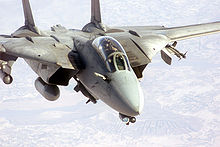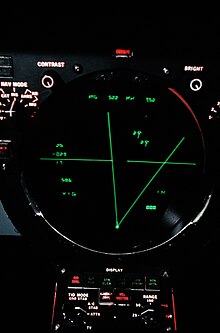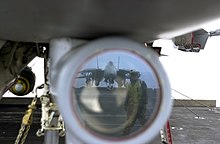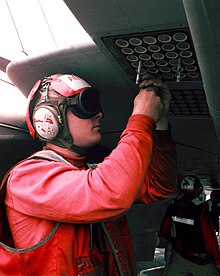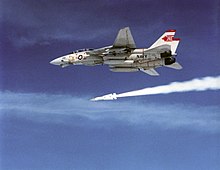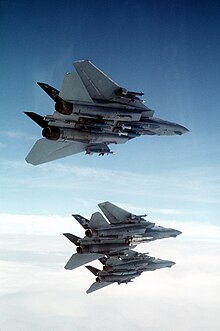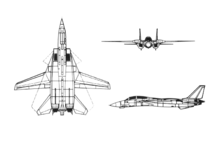Grumman F-14
| Grumman F-14 Tomcat | |
|---|---|

|
|
| Type: | Interceptor |
| Design country: | |
| Manufacturer: | |
| First flight: |
December 21, 1970 |
| Commissioning: |
September 22, 1974 |
| Production time: |
1972 to 1992 |
| Quantity: |
712 |
The Grumman F-14 Tomcat is a supersonic , twin- engine , swivel-wing , two-seat fighter aircraft developed for the United States Navy and used from 1974. Her primary duties in the US Navy were that of an air superiority fighter, scout and naval defense. Later on, rudimentary air-to-ground capabilities were added. The last Tomcat was decommissioned by the US Navy on September 22, 2006. The replacement is the F / A-18E / F Super Hornet . Today only the Iranian Air Force flies the F-14.
story
development
In the late 1950s, the US Navy was looking for a long-range interceptor with high endurance to defend its aircraft carrier combat groups against long-range anti-ship missiles that could launch from Soviet bombers and submarines. This Fleet Air Defense fighter (FAD) should have more powerful radar and guided missiles with greater range than the F-4 Phantom II to intercept enemy bombers and guided missiles. Under the direction of Secretary of Defense Robert McNamara , the Navy had to participate in the US Air Force's TFX program. McNamara wanted cross-force solutions to reduce costs and had already directed the Air Force to purchase the F-4 Phantom II, which was originally developed for the Navy and Marine Corps. The Navy protested violently because this compromise would have worsened the air combat properties of the aircraft.

When the TFX program threatened to fail, Grumman, who developed the naval version F-111B with General Dynamics, began with alternative aircraft designs. The F-111B was developed for the task of fleet defense and not as a dogfighter . In order to take into account the experience of the Vietnam War, the Navy investigated the development of an additional air superiority fighter with air-to-ground capabilities in the VFAX program. In July 1968, the Naval Air Systems Command (NAVAIR) published a tender for the Naval Fighter Experimental (VFX) program. A two-seater air superiority fighter with two engines and a top speed of Mach 2.2 was required. The armament of the VFX should be either six AIM-54 Phoenix or a combination of six AIM-7 Sparrow and four AIM-9 Sidewinder . A built-in M61 Vulcan was also required to provide close air support . Bids came from General Dynamics , Grumman (Model 303E / F), McDonnell Douglas (Model 225), Ling-Temco-Vought, Convair ( LTV V-507 Vagabond ) and North American Rockwell (Model D323). Four providers rely on swivel blades. McDonnell Douglas and Grumman were selected as finalists in December 1968. Finally, Grumman, who had built successful aircraft types for the Navy over and over again for three decades, was awarded the contract in January 1969. The draft provided for the Pratt & Whitney TF30 engines to be used from the F-111B, with these later being replaced by the Pratt & Whitney F401-400, which were still under development at the time. Although lighter than the F-111B, the machine was still the largest and heaviest carrier attack aircraft, as the large AN / AWG-9 radar and the six AIM-54 guided missiles and 7300 kg of fuel were to be transported.
The name "Tomcat" was chosen in honor of the role of Rear Admiral Thomas "Tomcat" Connolly, as he played an important role in the creation of the F-14. He performed flights with the prototype F-111A and found that it had difficulty reaching supersonic speed and was poorly suited for carrier landings. Connolly sacrificed the prospect of admiral promotion when he expressed his personal, unofficial, opinion on the F-111B in a public hearing of the Senate Armed Forces Committee when asked by the chairman.
Literally he said:
"There isn't enough thrust in Christendom to fix this plane."
"There isn't enough thrust in all of Christendom to get this plane out."
In addition, this nickname fits the tradition of the Navy, the aircraft from Grumman with feline names.
After Grumman signed the contract to build the F-14, the Calverton factory expanded significantly. Most of the tests were carried out from here. In order to save time, the prototype phase was skipped and serial production began immediately, which the US Air Force also did with the development of the McDonnell Douglas F-15 . The first flight of the F-14 therefore took place on December 21, 1970 - only 22 months after the contract was signed. This copy crashed a few days later during the approach due to a total failure of the hydraulic system. In the crash, the plane broke completely and the two pilots were able to save themselves with the ejection seat. The second test aircraft completed its maiden flight on May 24, 1971. The test program was completed after two years without any further serious problems, so that the Initial Operational Capability (IOC) 1973 was achieved. The United States Marine Corps originally planned to purchase F-14s to replace the F-4 Phantom II; officers were even sent to the VF-124 to be trained as instructors. However, after it became apparent that air-to-ground armament would no longer be pursued, the USMC withdrew its involvement.
The firing tests with the long-range missile AIM-54 Phoenix began in April 1972. The guided missile was fired at various targets, from cruise missiles to high-flying bombers. The furthest shot was carried out at 110 nautical miles (200 km) in April 1973. On November 22, 1973 six AIM-54 missiles were fired within 38 seconds at Mach 0.78 and 7600 m altitude, four of which hit guided missiles.
production
In September 1974 the aircraft carrier USS Enterprise (CVN 65) ran out of the Pacific Ocean. The first two F-14 squadrons VF-1 "Wolfpack" and VF-2 "Bounty Hunters" were on board as part of the on-board wing "Carrier Air Wing 14" . The Navy received a total of 478 F-14A aircraft, including the twelve prototypes, with which the McDonnell Douglas F-4 Phantom II and F-8 Crusader were replaced in fleet service. The production of the Tomcat put Grumman under severe financial pressure, as the contract with the Navy stipulated the unit costs. In addition, the late 1970s were a period of particularly high inflation in the United States. Fortunately, under the Shah, Iran decided to buy 80 tomcats, which saved Grumman from bankruptcy.
In the late 1970s, the Tactical Airborne Reconnaissance Pod System (TARPS) was developed for the F-14. Approximately 65 F-14As and all F-14Ds can carry this system. The TARPS was mainly controlled by the weapons system officer ( English Radar Intercept Officer, RIO ), who had a special display available for this purpose. The TARPS were equipped with a digital camera in 1996, which made them TARPS-DI. With the increase in combat value on TARPS CD from 1998, the images could now be transmitted in real time.
Some F-14A were upgraded to the GE-F110-400 engine in 1987. These enhanced Tomcats were listed as F-14A +, which was later (1991) changed to F-14B. At the same time, the development of the F-14D began, which received GE-F110-400 engines, improved avionics, glass cockpit and Link 16 . The Digital Flight Control System (DFCS) noticeably improved the handling of the F-14 at high angles of attack and / or in air combat.
When the A-6 Intruder was taken out of service in 1990, the F-14's air-to-ground program came into being. Bomb tests had already been carried out in the 1980s, and the Tomcat was able to use unguided bombs before then. After most of the air-to-ground missions were outsourced to the A-7 and F / A-18 in Operation Desert Storm, extensive modernization began after the war. The avionics and displays were improved in order to be able to fire precision-guided ammunition, the defense systems improved and the structure reinforced. The new avionics were comparable to the F-14D, the modernized machines were listed as F-14A (upgrade) and F-14B (upgrade).
In 1994 the Navy and Grumman presented an ambitious modernization plan to fill the gap between the A-6 and the arrival of the F / A-18E / F Super Hornet. Due to time and financial reasons, this was not done. A quick and inexpensive solution was the installation of a Low Altitude Navigation and Targeting Infrared for Night ( LANTIRN ). The pod supplied the F-14 with forward-looking infrared (FLIR) and a laser target illuminator for laser-guided bombs. The AN / AAQ-14 was later improved with a Global Positioning System and an inertial navigation system (GPS-INS) and was usually carried on the inner weapon mount on the right wing. An improved container called the LANTIRN 40K for altitudes above 40,000 feet was introduced in 2001, followed by Tomcat Tactical Targeting (T3) and Fast Tactical Imagery (FTI) to determine target coordinates and transmit the images in flight. In addition, the GBU-38 Joint Direct Attack Ammunition (JDAM) was scaffolded in 2003 in order to be able to choose between GPS and laser-guided weapons. Some F-14Ds were still equipped with ROVER III in 2005 in order to be able to transfer real-time images to the laptop of a Forward Air Controller .
Decommissioning
As the F-14 got older, Grumman proposed greatly improved versions known as "Super Tomcats". The first - called Quickstrike - was an F-14D with a navigation and aiming pod, additional weapon stations, and air-to-ground radar modes. The version was supposed to take on the role of the A-6 Intruder. The improvements were not sufficient for Congress, so Grumman designed the Super Tomcat 21 and marketed it as a low-cost alternative to the Navy Advanced Tactical Fighter (NATF). The aircraft would be based on the F-14 airframe and have upgraded AN / APG-71 radar. New GE F110-129 engines should allow a super cruising speed of Mach 1.3 and thrust vector control. The internal fuel supply should be increased and the control surfaces improved. The Attack Super Tomcat 21 should have even more fuel capacity, further developed control surfaces and the AESA radar of the A-12 Avenger II . The version ASF-14 (Advanced Strike Fighter-14) was even more advanced and would have been a largely new development. Ultimately, all the modifications turned out to be too costly. The US Navy ultimately chose the F / A-18E / F Super Hornet. On Friday, September 22, 2006, the last F-14 of the US Navy was ceremonially decommissioned at Naval Air Station Oceana in Virginia . The US announced on July 2, 2007 that all F-14s that could still be used would be scrapped. Today only the Iranian Air Force flies the plane.
Construction and technology
The F-14 was developed as an air superiority fighter and long-range interceptor. The pilot and the radar intercept officer (RIO for short) sit one behind the other in the cockpit, each on Martin-Baker GRU-7A ejection seats . The cockpit facilities are specialized for pilot and RIO and mostly not designed twice. The crew sits under a full-view hood that swings open to the rear. The cockpit is reached via fold-out steps.
Airframe
A characteristic feature of the aircraft are its swivel wings. In order to achieve high speeds for intercepting, they can be swiveled back and swiveled forward in slow flight. In general, the flight performance of the F-4 Phantom II should be surpassed in most parameters, for example through a higher climb performance. The wings are swiveled between 20 ° and 68 ° by the Central Air Data Computer (CADC) , depending on the air situation, in order to achieve the optimum ratio of lift to air resistance. The pilot can manually override the computer if necessary. On the ground, the wings can be swiveled by 75 ° to save space, especially on aircraft carriers. The wings consist of two-frame structures with integral fuel tanks. The torsion box, the swivel joints and the upper and lower outer skin of the wing are made of a titanium alloy. At higher speeds and thus higher swivel angles, the aileron and elevator functions are performed by the tailerons . Lifting aids on the entire leading and trailing edge of the wing further improve lift during landing or in aerial combat: the leading edge flaps are set to 17 ° for landing and 7 ° in combat, the trailing edge flaps to 35 ° for landing and 10 ° in air combat. The double rudder improves the yaw stability even at high angles of attack, without building the machine unnecessarily high.
In order to compensate for the changes in the pitching moment caused by the change in wing geometry in supersonic flight, the F-14A has small automatically extending triangular slats ( glove vane ) at the transition between cockpit and wing root. The problem here is that the aircraft is always aerodynamically stable, so the pressure point is always behind the center of gravity of the machine. By swiveling the wings, the pressure point is set further back; in addition, the pressure point moves further back during the transonic passage. In order to reduce the stability margin, which is far too high, the slats are extended from Mach 1.4, which pushes the pressure point further forward. This idea by chief engineer Bob Kress makes the Tomcat more agile in supersonic flight, so that 7.5 g maneuvers can still be flown at Mach 2 . The air brake consists of two surfaces between the engines, which can be spread up and down. Because of the catch hook, the lower half of the air brake is made in two parts. Due to the large area between the engines, the fuselage generates 40–60 percent of the total lift, depending on the pivot angle.
Avionics
On-board radar
The heart of the F-14 is the AN / AWG-9 radar from Hughes Aircraft. The radar, like the engines and the Phoenix guided missiles, was taken over from the F-111B. It is a pulse Doppler radar with look-down / shoot-down properties. The radar works in the X-band (8–12 GHz) with a planar, mechanically pivoted antenna 91 cm in diameter and two integrated rows of dipole antennas for friend-foe detection (IFF). The swivel range is 170 ° in azimuth and + 55 / −25 ° in elevation . The radar uses two traveling wave tubes , one for the continuous target illumination of the AIM-7 Sparrow missiles, the other for generating pulses in search mode. The pulse power is 10.2 kW. The radar is controlled by an 8-bit Intel 8080 microprocessor programmed in assembly language. The overall system consists of 26 modules, three for the computer, two for the power supply, four for the radar, the antenna, five for the signal processors , three for the transmitters , three systems for the guided missiles and five for the display of the results in the cockpit . The AWG-9 can pursue up to 24 targets at the same time and fight six of them with active radar-guided missiles ( AIM-54 , later also AIM-120 ). The location range should be around 207 km for a target with a radar cross-section of 1 m².
To search for airspace, the radar scans several horizontal strips. A total search divides the air space in the 170 ° search area into eight strips, so that a complete scan takes 13 seconds. If the target's motion vector is known, the scan area can be restricted to allow faster updates. The fastest scan takes only a quarter of a second and consists of just a strip over 10 °. Two and four strips in the range of 20 ° or 40 ° are possible in between. The weapon system officer can select the following radar modes:
- Pulse Doppler Scan (PDS): Outputs the angle and approach speed .
- Range-While-Scan (RWS): High pulse repetition rates to output range, angle and approach speed.
- Pulse-Doppler-Single-Target-Track (PDSTT): For locating sources of interference while their approach speed is measured.
- Track-While-Scan (TWS) : Steering of Phoenix is only possible with two or four strips in the range of 20 ° or 40 °. Time-sharing enables six guided missiles to be directed at six different targets.
- Vertical Scan Lock-on (VSL): A 40 ° high strip in the vertical is searched in order to lock targets in dogfight. The 4.8 ° wide radar beam works either in the range + 25 / −15 ° or + 55/15 °.
- Pilot-Rapid-Location (PRL): Dogfight mode, this time horizontally with a beam with a 2.3 ° opening angle.
- Continuous-Wave (CW): Target lighting for the semi-active Sparrow.
The AWG-9 can also be coupled to the IRST in all operating modes. In this case, the target is passively acquired and the radar illuminates the target in due course. In the F-14D, the AWG-9 was replaced by the more modern APG-71. Except for the transmitter, power supply and the cockpit displays, all parts have been modernized. Components of the AN / APG-70 of the F-15C / D Eagle were used. The clutter suppression has been improved, a new antenna with low side lobes has been installed, a channel for side lobe suppression has been integrated and the monopulse angle tracking mode has been added. Later target data of the Joint Tactical Information Distribution System could also be displayed.
Electro-optical systems
The first F-14A were equipped with a steerable AN / ALR-23 infrared aiming system under the nose that could either track the radar or be used independently. In the early 1980s, the IRST was replaced ex works by the Northrop AN / AXX-1 Television Camera Set (TCS), and older models were upgraded with the device. The system uses two vidicons , one for a narrow field of view and one for a wide field of view. The fully stabilized telescope is located in a cylinder with a quartz window and can aim at targets in a 30 ° cone in front of the Tomcat. The tracking rate is 30 ° / s, whereby the system can also handle tracking rates of 150 ° / s. For the wide field of view, a 5/8 inch diameter vidicon is used to create a 1.5 ° field of view. For the narrow field of view, a small Cassegrain telescope and a 1-inch vidicon are used to reduce the field of view to 0.5 °.
As a special feature, the AN / AXX-1 has a video tracker: The electronics look for a certain feature in the image and the telescope tracks it by comparing the position of the feature in the image from frame to frame. Another special feature is the option of having the TCS search the airspace. If a possible target is recognized, the TCS automatically switches on and tracks it. The radar can be linked to the TCS so that they both take the same line of sight to improve ECCM capability. Even if the radar is jammed, the target can still be tracked. The radar then does not know what it is illuminating in CW mode; for the AIM-7 Sparrow missile, however, this is irrelevant. Since the radar does not have a non-cooperative target identification mode , the AN / AXX-1 is the only way to do this. The video image is presented to the weapons system officer on a cathode ray tube screen. The identification range is 85 nm (153 km) for a DC-10 , 40 nm (72 km) for an F-111 , 35 nm (63 km) for a C-130 and 10 nm (18 km) for an F- 5 .
Defense systems
The following table lists all known and compatible EloKa systems and decoy launchers for the F-14:
| designation | Accommodation | Remarks |
| Radar warning systems | ||
| AN / APR-45 | internally | for F-14A |
| AN / ALR-50 | internally | for F-14A |
| AN / ALR-67 | internally | for F-14B |
| AN / ALR-67 (V) 2 | internally | for F-14D |
| Missile warning systems | ||
| none | ||
| Decoys launcher | ||
| AN / ALE-39 / -29 | internally | for F-14A |
| AN / ALE-47 | internally | retrofitted on all machines |
| AN / ALE-50 | internally | for F-14D |
| AN / ALE-58 | external | |
| Disruptive systems | ||
| AN / ALQ-100 | external | |
| AN / ALQ-126 | internally | for F-14A |
| AN / ALQ-126B | internally | |
| AN / ALQ-165 | external | for F-14D |
| AN / ALQ-167 | external | for F-14A / B / D |
Engines
The two Pratt & Whitney TF30 engines are turbofans with a low bypass ratio and were originally developed (that is, afterburner-free) for the F6D Missileer and later installed in the F-111 with an afterburner. The TF30 was the first twin-shaft turbofan with post-combustion that was put into service by the military. The F-14 reaches a top speed of about Mach 2.35 with the approximately 93 kN afterburner thrust. As a rule, however, the fuel-efficient subsonic flow was used to allow longer patrols . The engines sit in individual housings under the fuselage. The main reason for this configuration was that it ensured a good air supply for the engines, which was a big problem for the F-111, among others, and the engines are easily accessible for maintenance crews. Each engine has a wedge-shaped air inlet with an adjustable ramp on the neck to improve total pressure recovery in the supersonic and is slightly angled outwards. In addition to the internal tank capacity of around 7350 kg, an external tank with 1,100 liters of fuel can be carried under each engine housing. On the right side of the cockpit there is another retractable probe for air refueling.
The TF30 bypass engine has nine low pressure stages, three of which are for the fan. The bypass ratio is 0.878: 1, with the air in the bypass flow being compressed by 2.14: 1 by the fan. The core flow is compressed by the following high-pressure compressor in seven stages to a total pressure ratio of 19.8: 1. The fuel is burned in the ring tube combustion chamber with eight chambers and enters the turbine at 2150 F (1450 K). A single-stage, cooled high-pressure turbine and a three-stage, uncooled low-pressure turbine are passed. This is followed by the afterburner and the hydraulically adjustable convergent-divergent nozzle. Due to the high curb weight of 4251 lbs (1928 kg) only a thrust-to-weight ratio of 5.26: 1 is achieved. The mass flow through the engine at a rated output of 94.8 kN in afterburner operation is around 110 kg / s. The dimensions of the engine are approximately 5969 mm × 1300 mm. The specific consumption in afterburner operation is 73 g / kNs, in dry thrust it is around 24 g / kNs.
The relatively low power of the TF30 engines in relation to the empty weight of the aircraft aroused criticism. John Lehman, Secretary of the Navy in the 1980s, told Congress that the TF30 / F-14 combination was "probably the worst engine / airframe combination in years" and that the TF30 was a "terrible engine." 28% of all F-14 losses were caused by the engines. The turbine blades often failed, so the engine room had to be reinforced to limit the damage. The engines were also very susceptible to compressor stall . The TF30 only gave the F-14 a thrust-to-weight ratio of 0.56 at maximum takeoff weight - considerably less than the F-15A, which reached 0.85. The F-14D were equipped with the F110-GE-400 , which improved the values to 0.73 and 0.88 with normal take-off weight. The total pressure ratio improved here to around 30: 1, the turbine inlet temperature after the annular combustion chamber increased to 1783 K. The specific consumption in afterburner operation could be reduced to 65 g / kNs, the consumption in dry thrust remained the same. Thanks to the afterburner thrust, the thrust-to-weight ratio improved from around 120 kN to 6.1: 1. The mass flow increased to 122 kg / s at nominal load.
Armament
The main weapon of the Tomcat is the large Hughes AIM-54 Phoenix with 200 km range and active radar. The Tomcat does not have to illuminate the target with the on-board radar in the final missile approach. In principle, the missile should enable the Tomcat to destroy intruders at very great distances. The Phoenix missile was also taken over from the F-111B and represents the last development stage of the Falcon series of air-to-air missiles. It could only be carried by the Tomcat. A maximum of six Phoenix missiles could be carried (four in the "tunnel" under the fuselage and two on wing pylons). However, the rockets are so heavy that a Tomcat could not land with six of them on a carrier. In addition, due to the two additional missiles on the wing pylons, the air resistance is so high that the flight performance, in particular the range, is significantly reduced.
In practice, the standard armament consisted of four Phoenix and two semi-active (SARH) missiles AIM-7 Sparrow and two heat-seeking AIM-9 Sidewinder for close combat. The Sparrows and Sidewinders are hung from a double pylon at the wing root under cramped conditions, as the wings can be pivoted. If no Phoenix are carried, four more AIM-7s can be mounted under the fuselage. For close aerial combat, the Tomcat has a Gatling M61 Vulcan cannon with 675 rounds of ammunition mounted on the left under the cockpit . The F-14 Tomcat was also able to use precision-guided ammunition from the Paveway and JDAM series to combat ground targets.
The Tomcat was used as a reconnaissance aircraft early on. In 1979 the Naval Air Test Center in Patuxent River, Maryland began developing the TARPS (Tactical Air Reconnaissance Pod System) for the Tomcat. TARPS was developed from a reconnaissance system for the Vought A-7 Corsair that was never ready for series production. The aerodynamic container is approximately 5.18 m long and weighs 794 kg. It contains a camera in the nose, another panorama camera in the middle part and an infrared scanner in the rear part. The TARPS container is hung on the right rear station in the fuselage tunnel. Since it requires additional electrical wiring, 50 tomcats were specially converted for TARPS. The system is controlled by the radar interception officer in the back seat, who has an additional TARPS display on which he can follow the reconnaissance data. The pilot can switch the cameras on and off using a switch on the control stick.
TARPS was introduced into the fleet in 1980 and proved to be very valuable, as the RF-8G Crusader, the last specialized reconnaissance aircraft, retired from active service at that time. Actually, TARPS was only supposed to be an interim solution, as the US Navy hoped to receive a reconnaissance version of the McDonnell Douglas F / A-18 Hornet soon , which however never happened. Instead, the TARPS tomcats became the Navy's permanent tactical reconnaissance platform. The following list shows all armament options:
- Permanently installed on-board cannon
- 1 × 20 mm Gatling - machine gun M61A1 Vulcan with 675 rounds of ammunition
- Weapons with a maximum total weight of 6,600 kg can be carried at ten external load stations.
- Air-to-air guided missile
- 4 × LAU-138 / A start rails for 1 × Raytheon AIM-9B / D / E / H / L / M / N / P "Sidewinder" each
- 6 × LAU-92 start rails for 1 × Raytheon AIM-7E-4 "Sparrow" each
- 4 × LAU-128 start rails for 1 × Raytheon AIM-120B "AMRAAM" each; no operational readiness for use
- 6 × LAU-93 start rails / LAU-132 start rails for 1 × Raytheon AIM-54 "Phoenix" each
- Guided bombs
- 4 × Lockheed-Martin GBU-12C / B "Paveway II" (laser-guided 227 kg / 500 lb glide bomb)
- 2 × Lockheed-Martin GBU-24 / B "Paveway III" (laser-guided 1,050 kg / 2,000 lb glide bomb)
- 4 × GBU-38 / B "JDAM" (GPS-guided 227 kg / 500 lb bomb)
- 4 × GBU-31 / B "JDAM" (GPS-guided 924 kg / 2,036 lb bomb)
- Unguided bombs on ADU-703A / A suspension
- 4 × BRU-32 / A bomb racks with 1 × BLU-111A / B LDGP each (227 kg free-fall bomb , analogous to Mk.82 with thermal protective coating)
- 4 × BRU-32 / A bomb rack with 1 × BLU-110A / B LDGP each (454 kg / 1,000 lb free-fall bomb, analogous to Mk.83 with thermal protective coating)
- 4 × BRU-32 / A bomb racks each with 1 × Mark 84 LDGP (907 kg / 2,000 lb free-fall bomb)
- 4 × BRU-32 / A bomb racks each with 1 × Mark 20 "Rockeye II" (CBU-100) (222 kg / 490 lb anti-tank cluster bomb with 247 Mk.118 bomblets)
- External container
- 1 × TARPS (Tactical Airborne Reconnaissance Pod System)
- 1 × AN / AAQ-14 "LANTIRN" target light container
- 2 × MXU-611 suspension, each with 1 × drop-off additional tank for 1,010 liters (2,000 lbs) of kerosene
- 1 × Rodale AN / ALQ-167 (V) 1X (electronic jamming container)
- 1 × CNU-188 / A (external luggage container)
Versions
- F-14A
- First production version (delivered from 1973) for the US Navy (554 pieces).
- F-14A / TARPS
- F-14A which, equipped with the TARPS system, were used as reconnaissance aircraft (50 pieces).
- F-14A (Plus)
- The main difference between this version, built from November 14, 1987, and the F-14A are the new F110-GE-400 engines from General Electric. This replacement became necessary because the originally installed TF30 engines from P&W could not be satisfactory at any time. They were inefficient, difficult to maintain, and moreover unreliable and prone to accidents. The most common cause of the loss of Tomcats was that turbine blades broke off, flew through the engine and destroyed it in the process. In 1991 the F-14A (Plus) was renamed the F-14B (newly built: 38 units, converted F-14A: 47 units, total: 85 units).
- F-14B
- Prototype of an F-14 with F401-P-400 engines (2 pieces). One model flew on September 12, 1973, the second was not completed and the program was discontinued for cost reasons. From 1991 designation for the F-14A (Plus).
- F-14C
- Planned development of a Tomcat with TF30-P-414A engines and more modern avionics, program discontinued for cost reasons.
- F-14D
- The F-14D delivered from 1990 or converted from older aircraft represent a fundamental modernization within the framework of the limited expansion options of the aircraft. New are the AN / APG-71 radar system, digital flight control, improved countermeasures for self-protection, night vision compatibility, target transfer capacity and various components that now enable the F-14 to attack ground targets (this was not intended when the aircraft was originally designed). (Newly built: 37 pieces, converted F-14A: 18 pieces, total: 55 pieces)
- Super Tomcat21
- planned further development of the F-14D, should have twice the combat radius of an F-14D. Two versions were to be produced, including an attack variant. However, this program was discontinued in favor of the F / A-18 E / F Super Hornet .
Deliveries
Iran received a total of 79 F-14As delivered between 1976 and 1978.
Deliveries of the F-14 to the US Navy:
| version | 1971 | 1972 | 1973 | 1974 | 1975 | 1976 | 1977 | 1978 | 1979 | 1980 | 1981 | 1982 | 1983 | 1984 | 1985 | 1986 | 1987 | 1988 | 1989 | 1990 | 1991 | 1992 | 1993 | 1994 | 1995 | TOTAL |
|---|---|---|---|---|---|---|---|---|---|---|---|---|---|---|---|---|---|---|---|---|---|---|---|---|---|---|
| F-14A | 4th | 9 | 32 | 60 | 71 | 45 | 36 | 44 | 38 | 30th | 30th | 30th | 30th | 26th | 21st | 27 | 8th | 16 | 557 | |||||||
| F-14A plus / B | 1 | 17th | 15th | 5 | 38 | |||||||||||||||||||||
| F-14D | 11 | 16 | 5 | 4th | 1 | 37 | ||||||||||||||||||||
| TOTAL | 4th | 9 | 32 | 60 | 71 | 45 | 36 | 44 | 38 | 30th | 30th | 30th | 30th | 26th | 21st | 27 | 8th | 17th | 17th | 15th | 16 | 16 | 5 | 4th | 1 | 632 |
Calls

During the evacuation of Vietnam in 1975, the new Tomcats flew hunting protection but were not involved in fighting. The F-14A first encountered enemy aircraft over the Mediterranean in 1981. Libya's head of state Muammar al-Gaddafi had declared the Gulf of Sidra to be Libyan territorial waters. US President Ronald Reagan brought the USS Nimitz carrier group into the Gulf to challenge Gaddafi. On August 18, 1981, there was a confrontation between two Tomcats and Libyan jets, during which no shots were fired. The next day the Libyan pilots were more aggressive. Two fighter bomber type Suchoi Su-22 attacked two Tomcat the VF-41 Black Aces (nickname "Fast Eagle 102" and "Fast Eagle 107") to. The leading Su-22 fired an air-to-air missile, which, however, did not pursue its target. The two F-14s returned fire with AIM-9L Sidewinder missiles and shot down the Libyan planes.
In October 1985, began four Tomcats - VF-74 Bedevilers and VF-103 Sluggers , stationed on the USS Saratoga - an Egyptian Boeing 737 from the terrorists on board was that the Italian cruise ship Achille Lauro had kidnapped.
In March 1986, Libya fired surface-to-air missiles at F-14s of the USS America and USS Saratoga (CV-60) patrolling the Gulf of Sidra . As a countermeasure, mixed attack groups from America , Saratoga and Coral Sea destroyed the missile position and sank some Libyan patrol boats. In late 1986, Tomcats flew fighter protection for the bombing of Tripoli and Benghazi by F-111 Aardvarks during Operation El Dorado Canyon . In January 1989, two VF-32 Swordsmen tomcats destroyed two attacking Libyan MiG-23 Flogger-B missiles with AIM-9 Sidewinder and AIM-7 Sparrow missiles.
During the Gulf War in 1990/91, the F-14 flew armed air patrols (CAP) and reconnaissance missions. The only shot down was a Tomcat from the VF-1 Wolfpack . It destroyed an Iraqi Mi-8 - "hip" helicopter. The VF-103 Sluggers , based on the USS Saratoga (CV-60), lost a Tomcat to an Iraqi surface-to-air missile during a TARPS reconnaissance mission over Wadi Amif. The F-14Bs and Ds were equipped with newer ground aiming systems and laser designators (LANTIRN), some of which were taken over from the F-15E Strike Eagle. They were now able to accurately drop both free-falling and laser-guided bombs. The "new" F- 14s were now jokingly called Bombcat .
F-14s were used in Operation Deliberate Force in 1995, Operation Desert Fox in 1998 , and Operation Allied Force in 1999 . In 2001 the Joint Direct Attack ammunition was scaffolded and in 2002 some bombing raids were carried out in Afghanistan during Operation Enduring Freedom . F-14s also participated in Operation Iraqi Freedom .
Iranian Air Force
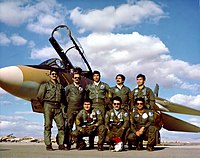
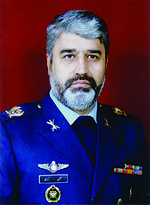
Iran was the only export customer to buy 80 tomcats during the time of the Shah. The last machine ordered was not delivered there because the Islamic Revolution had broken out in Iran in the meantime . On the US side, this development led to hectic activity, because one of the most modern US fighter aircraft at the time had fallen into the hands of a potential opponent. In a hurry, all American tomcats received new software for the radar at that time in order to make the Iranian knowledge of the system worthless, at least in part.
The F-14 Tomcat proved very valuable to the Air Force of the Islamic Republic of Iran (IRIAF) in the war against Iraq . While the F-4E Phantom and Northrop F-5E Tiger II of the IRIAF were mainly used for attacks against ground targets, the IRIAF used their F-14 for pure air-to-air combat. In the eight years of the Iran-Iraq war, Iranian tomcats, of which only a dozen were sometimes operational due to the lack of spare parts, shot down a total of 152 Iraqi fighter jets and helicopters, 18 of which could not be confirmed, and damaged eight more. During that time, the Iraqis only managed to destroy eight of the tomcats. This is explained by the order of the Iraqi Air Force to flee immediately if their machines were detected by the fire control radar of an F-14. Two other Iranian tomcats were mistakenly shot down by their own air defense during the war (so-called " friendly fire ").
An Iranian F-14 was first shot down on September 10, 1980 when an 81TFS / TFB.8 machine destroyed an Iraqi MiG-21 . On October 29, 1980, an American AWACS machine recorded the downing of an Iraqi medium-range bomber of the type Tupolev Tu-22 "Blinder" of the 10th BS by an Iranian Tomcat of the TFB8. An Iraqi machine was last shot down by Iranian F-14s in the first Gulf War on June 14, 1988, when a Tomcat of the 81TFS / TFB.8 destroyed a Dassault Mirage F1 EQ of the Iraqi Air Force with an AIM-9P.
The Iranian pilot Major Jalil Zandi (TFB.8 of the IRIAF) is the world's most successful F-14 pilot with nine kills (nine according to US intelligence analyzes, twelve according to Iranian sources), which is one of the reasons why he was able to trump his US colleagues, because these are withdrawn from the combat area after a certain period of use. Zandi, on the other hand, was on duty for almost the entire eight years of the Iran-Iraq war. Zandi retired with the rank of brigadier general and died in a traffic accident in 2001.
Even today, more than 20 years after the embargo, Iran has at least 40 operational F-14As that were presented in mass formation flights at military parades in 2004. The old desert camouflage with the colors sand yellow, dark green and brown was replaced in 2004 by a light gray-dark gray camouflage pattern. It is speculated that Iran modified and improved part of its F-14s with Russian help.
Technical specifications



- Data from US Navy Fact File:
| Parameter | F-14A Tomcat data | F-14D Super Tomcat data |
|---|---|---|
| crew | Pilot and Radar Intercept Officer (RIO) | |
| length | 19.10 m | |
| span |
Swiveled out: 19.55 m |
|
| height | 4.88 m | |
| Wing area | 52.49 m² | |
| Wing extension |
|
|
| Wing loading |
minimum (empty weight): 347 kg / m² |
minimum (empty weight): 361 kg / m² |
| Empty mass | 18,191 kg | 18,951 kg |
| normal takeoff mass | 27,215 kg | 27,760 kg |
| Max. Takeoff mass | 32,805 kg | 33,724 kg |
| internal tank capacity | 7,348 kg | 7,351 kg |
| Top speed | Mach 2.37 or 2517 km / h (at 10,975 m) | Mach 1.88 or 1996 km / h (at 10,975 m) |
| Service ceiling | 17,070 m | 16,154 m |
| Rate of climb | 229 m / s | 244 m / s |
| Use radius | 1167 km | 926 km |
| Range | 3220 km | 2960 km |
| Engine | two turbofan engines Pratt & Whitney TF30P-412A | two turbofan engines General Electric F110-GE-400 |
| Thrust |
with afterburner: 2 × 92.9 kN |
with afterburner: 2 × 120.49 kN |
| Thrust-to-weight ratio |
maximum (empty weight): 1.04 |
maximum (empty weight): 1.3 |
Media reception
The Tomcat was the secret star in the 1986 US movie Top Gun with Tom Cruise , which showed the jet in all conceivable flight positions. The film was shot with great support from the US Navy and the United States Department of Defense and did not fail to have an impact. Shortly after it opened in theaters, young men stormed the Navy recruiting offices and wanted to become Tomcat pilots. In the film, one of the main characters has a fatal accident in a crash due to massive engine problems after flying through the exhaust jet of the machine flying in formation in front of him. The script was reviewed and approved by the Navy before production began.
Already in 1980 the F-14A of the VF-84 Jolly Rogers squadron - with the pirate flag, the " Jolly Roger ", on the two vertical stabilizers - could be seen in the film The Last Countdown .
In the American television series JAG - On behalf of the honor (1995-2005), the main character Harmon Rabb Jr. is a former F-14 pilot. Missions or accidents involving the F-14 also play a role in many episodes.
Web links
- Markus Becker: USA are retiring “Tomcat”. In: Spiegel Online . December 19, 2005.
- F-14 Tomcat. In: Federation of American Scientists . April 23, 2000
- HOME OF MATS - The F-14 Reference Work. In: anft.net , (engl.)
Individual evidence
- ↑ Tommy Thomason: Grumman Navy F-111B Swing Wing (Navy Fighters No. 41). Steve Ginter, Simi Valley 1998, ISBN 0-942612-41-8 .
- ↑ The McDonnell F-4 Phantom II. In: aviation-history.com
- ↑ Spangenberg Fighter Study Dilemma ( Memento from February 4, 2012 in the Internet Archive )
- ↑ a b Capt. ET Woolridge (Ed.): Into the Jet Age. Conflict and Change in Naval Aviation 1945-1975, an Oral History. Naval Institute Press, Annapolis 1995, ISBN 1-55750-932-8 .
- ↑ a b c d e Mike Spick: F-14 Tomcat. In: The Great Book of Modern Warplanes. MBI Publishing Company, St. Paul 2000, ISBN 0-7603-0893-4 .
- ^ Bill Gunston, Mike Spick: Modern Air Combat. Crescent Books, New York 1983, ISBN 0-517-41265-9 .
- ↑ Robert Mcg. Thomas Jr: Thomas Connolly, 86, Top-Gun Admiral, Dies. In: New York Times . June 9, 1996. Retrieved July 8, 2017.
- ↑ George Marrett: Flight of the Phoenix. Airpower, Volume 36, No. July 7, 2006.
- ↑ a b Dennis R. Jenkins: F / A-18 Hornet. A Navy Success Story. McGraw-Hill, New York 2000, ISBN 0-07-134696-1 .
- ↑ FliegerWeb.com: Development history of the Grumman F-14 Tomcat. In: fliegerweb.com.
- ^ New York Magazine: How the Pentagon silenced Grumman. May 9, 1977.
- ^ A b c David Donald: Northrop Grumman F-14 Tomcat, US Navy today. In: Warplanes of the Fleet. AIRtime Publishing Inc, London 2004, ISBN 1-880588-81-1 .
- ↑ sdl.usu.edu Space Dynamics Laboratory: Tactical Air-borne Reconnaissance Pod System - Completely Digital. Retrieved April 22, 2012.
- ↑ Torsten Anft: F-14 Bureau Numbers. Home of MATS Retrieved September 30, 2006.
- ^ Norman Friedman: F-14. In: The Naval Institute Guide to World Naval Weapon Systems. Fifth edition, Naval Institute Press , Annapolis MD 2006, ISBN 1-55750-262-5 .
- ↑ F-14 upgrades. In: global security.org. Retrieved March 24, 2012.
- ^ A b Greg Gobel: Bombcat / Tomcat In Service 1992: 2005. Vectorsite.net , November 1, 2006. Retrieved December 8, 2009.
- ↑ navy.mil The US Navy - Fact File: F-14 Tomcat fighter. Retrieved April 22, 2012.
- ↑ "US Navy's F-14D Tomcats Gain JDAM Capability." ( September 23, 2007 memento on the Internet Archive ) Navy Newsstand (United States Navy), March 21, 2003. Accessed June 16, 2019.
- ↑ "ROVER System Revolutionizes F-14's Ground Support Capability." ( Memento from November 24, 2006 in the Internet Archive ) Navy Newsstand (United States Navy), December 14, 2005, accessed June 16, 2019.
- ↑ David Donald: Warplanes of the Fleet. AIRtime Publishing Inc., London 2004, ISBN 1-880588-81-1 .
- ^ Robert F. Dorr: F-14 Tomcat. Fleet Defender. In: World Air Power Journal. Volume 7, Aerospace Publishing, London 1991, ISSN 0959-7050 , pp. 42-99.
- ↑ a b Joe Baugher: Grumman F-14A Tomcat. In: Joe Baugher's Encyclopedia of American Military Aircraft. February 13, 2000.
- ^ WH Mason: Some Supersonic Aerodynamics - Configuration Aerodynamics Class. Accessed August 15, 2013 (PDF; 71.1 MB)
- ↑ F-14 Tomcat Design. In: GlobalSecurity.org . Retrieved August 15, 2013.
- ↑ a b c d AWG-9 Weapon Control System ( Memento from August 29, 2013 in the Internet Archive )
- ↑ a b ausairpower: Flanker Radars in Beyond Visual Range Air Combat. April 3, 2008
- ^ A b Bill Sweetman, Ray Bonds: The Great Book of Modern Warplanes. Crown Publishers, New York 1987, ISBN 0-517-63367-1 .
- ^ A b Carlo Kopp: Electro-optical Systems. In: ausairpower.net. Australian Aviation, March 1984.
- ↑ a b ausairpower: F − 14 TF30 − P − 414 TO F110 − GE − 400 ENGINE UPGRADE TECHNICAL COMPARISON. In: ausairpower.net. (PDF; 47 kB), accessed on August 18, 2013.
- ↑ Nico Sgarlato: F-14 Tomcat. Aereonautica & Difesa magazine Edizioni Monografie SRL., December 1988.
- ^ Robert F. Dorr: F-14 Tomcat. Fleet Defender. World Air Power Journal, Volume 7, Aerospace Publishing, London 1991, ISSN 0959-7050 , pp. 42-99.
- ↑ Tony Holmes: US Navy F-14 Tomcat Units of Operation Iraqi Freedom. Osprey Publishing Limited, London 2005, ISBN 1-84176-801-4 .
- ↑ anft.net
- ^ Aerospace Industries Association: 1973/74 to 1996/97 Aerospace Facts and Figures
- ↑ Tom Cooper (author) , Liam F. Devlin: The Guardians of Iranian Airspace. Fliegerrevue Extra No. 27, p. 63.
- ↑ Tom Cooper, Farzad Bishop , Brigadier General Ahmad Sadik: The "Persian Kater". Fliegerrevue Extra No. 14, p. 21.
- ↑ Iran: Satellites and Tomcats ( Memento of March 10, 2009 in the Internet Archive )
- ^ US Navy fact files. Retrieved June 16, 2019 .
- ↑ TV feature film online: The latest news from film, cinema and TV. Accessed June 16, 2019 (German).

